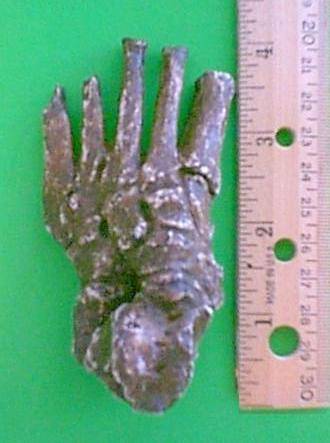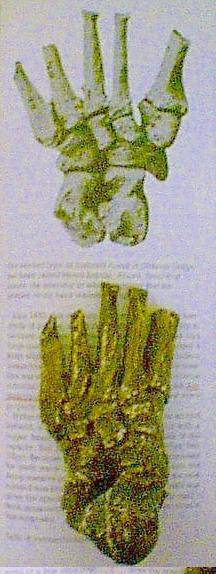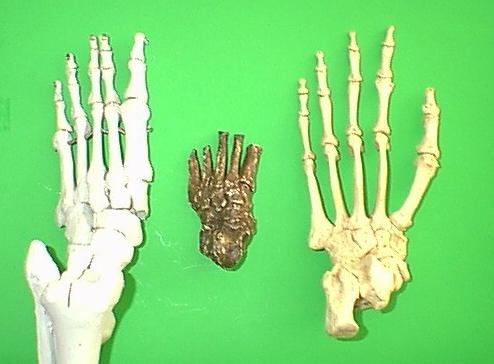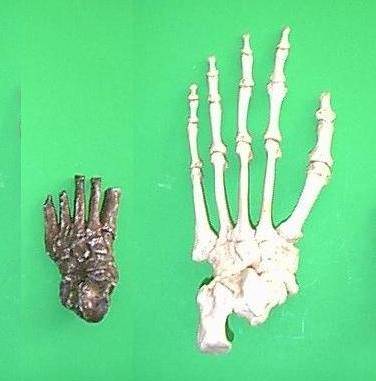
All text and images are protected under U.S copyright law.
Do not use without permission.


All text and images are protected under U.S copyright law.
Do not use without permission.


The feet of Homo habilis are represented by the specimen OH 8 (Olduvai hominid number 8). These are the left tarsal and metatarsal bones of an adult. OH 8 is missing the phalanges (Day, 1968, pg 132)
metatarsal: belonging or relating to the bones between the toes and ankle 2) any of the set of bones between the toes and ankle
 |
Here is a picture of my cast of Olduvai hominid 8 ("OH 8"). OH 8 consists of a dozen ankle and foot bones of a left foot. This foot, missing only the phalanges is remarkable in its completeness. It was discovered my Mary Leakey, and placed on record by her husband Louis Leakey in 1960 (pg 18-19, Homo habilis)
I recieved my cast of OH 8 on 10/16/01, and the first thing that I noticed about 0H 8 was its small size. It is only about 4 inches long. |
|
"OH 8 - a fairly complete foot - was found nearby OH 7, and was initially determined to be from another individual. This was due to the fact that OH 7 was known to be from an adolescent around age 12, and the foot seemed to be of a more advanced age, due to the presence of arthritis in the specimen. However, the partially gnawed remains have arthritis die to a sustained injury, and the actual age runs close to OH 7, making it likely they are from the same individual (many researchers consider this part of OH 7 now, rather than OH 8). The remains show clear signs that this was an obligate biped, including:
Presence of digital shortening. Enlargement of the hallux, as well as being fully abducted. Alignment of digits 2-5. Thickened metatarsal shaft with a humanlike cross-sectional shape. A fully developed double arch to the lower surface. Mechanically set up for efficient weight transmission at the ankle. While it shows definite obligate bipedalism, the specimen also has a marked tubercule for the tibialis posterior muscle, an invertor of the foot that could be usefull for climbing. So it is possible that while this individual was an obligate biped, it still spent some time in the trees (which goes well with paleoecological evidence that suggests that various hominid species spent most of their time in marginal woodland environments). |
Humans have a high arch in their foot, while apes are all "flat footed" (pg 301, "Anatomy & Physiology: The unity of form and function" by Saladin). This arch serves as a spring that helps us obsorb the shock of walking and running.
This flat footed condition may be a new one for the apes, as there is evidence that some of the apes like Homo habilis had a small arch to the foot. My request to view the original specimen of OH8 (Homo habilis) was rejected, so I may never know if the foot has been assembled properly. I can only rely on the (in)accuracies of a cast purchased from the National Musuem of Kenya, and papers published by men with the same agenda (pro-evolution) that the people who reconstructed the foot had.
 |
My gut tells me it has not been reconstructed accuratly. You will see in Leakeys book "Origins" a hallux (big toe) that is divergent (sticks out to the side) the way they do in apes, but in other pictures (M. Day for instance) you see the toe has been pushed in so that it is inline with the other toes. The bones of this foot were nearly complete lacking only the phalanges, so such a discrepancy in these two reconstructions should not exist. |

 Picture from Day pg. 70 |
If the toe has been pushed in, then an artificial arch may have been created as well. But because these apes were bipeds originally they may have had a small arch similar to man.

| The same day I recieved the OH 8 foot bones, I also recieved the Homo habilis leg bone KNM-ER 1481 (on 10/16/01). Either one of these creatures is an adult, and the other a child, or these are not the same creature.
The leg bone of Homo habilis is far too big for the foot. There is no question these are from 2 individuals, but they may also belong to 2 different species. |
M. Day says this about OH 8: "It is clear from a preliminary examination that the principle affinities of this foot, despite its small size, are with Homo sapiens"
(M. Day 1968, pg 132)
Let me make it clear, Day is not saying that OH 8 was a Homo sapien foot. He is saying they are similar.
Similar because when you see the picture in Day's book you see that the big toe is in line with the other toes, the way it is in our feet.

| Here is a picture of OH 8 (Homo habilis)center, compared to the foot of a chimpanzee (left) and a human (right). The bone at the base of the great toe is in line with the others in Homo habilis like it is in modern humans. This helps in walking but not grasping. |

|


 |
 |
Journal of Human Evolution Vol. 31, No. 3, September 1, 1996 ISSN: 0047-2484 EISSN: 1095-8606 The OH8 foot: a reappraisal of the functional morphology of the hindfoot utilizing a multivariate analysis pp. 269-291 (doi:10.1006/jhev.1996.0061) R. S. Kidd*, P. O'Higgins, C. E. Oxnard --------------